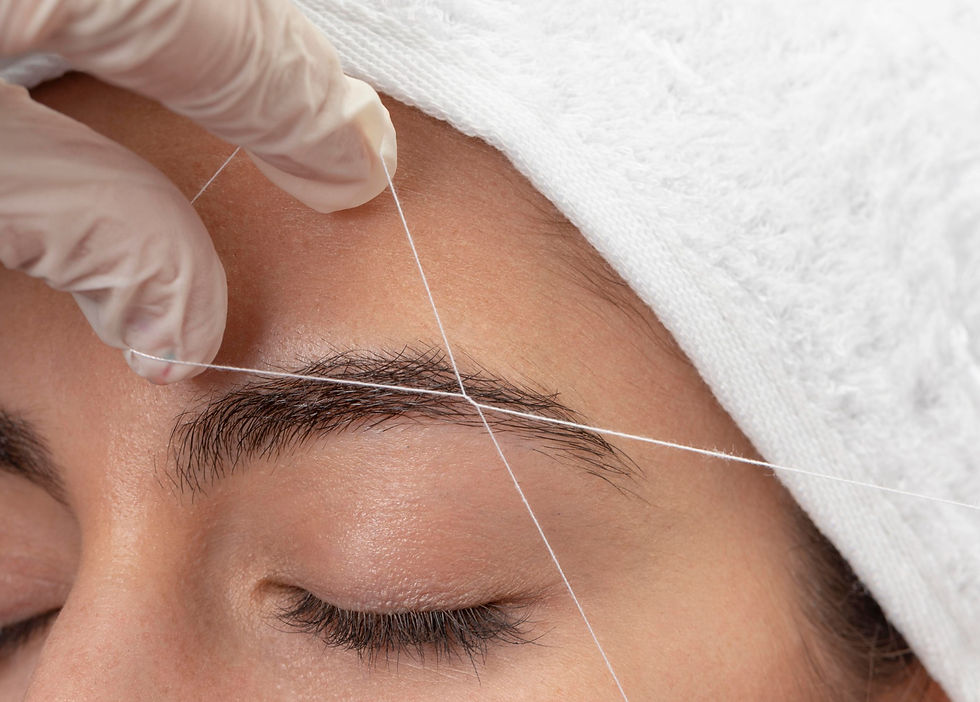What Is Eyebrow Threading: Everything You Need to Know
- Zachary DeLorenzo
- Jul 30
- 3 min read

Eyebrow threading is an ancient hair removal method that many people are curious about today. This guide explains what threading is, how it works, and why it's become so popular. Many Los Angeles beauty salon professionals use this technique because it gives precise, long-lasting results. We'll cover the history, benefits, process, aftercare tips, and clear up common myths about threading.
Origins of Eyebrow Threading
Eyebrow threading started over 6,000 years ago in India and Central Asia. Back then, it wasn't just about beauty - it was part of their culture. Skilled workers used simple cotton thread to shape eyebrows into detailed patterns that showed a person's social status. The technique slowly spread to other countries because people loved its precision and durability. Today, threading is used worldwide because it creates clean, well-shaped eyebrows that look natural.
Benefits of Eyebrow Threading
Threading offers many advantages over other hair removal methods:
Precision: The thread can target exact hairs, giving you perfect eyebrow shapes
Long-lasting: Results stay good for 4-6 weeks before you need another session
Less Irritation: Much gentler on skin than waxing, with less redness and swelling
Suitable for Sensitive Skin: Perfect for people with sensitive skin or those using acne medications
Threading gives you clean, well-defined eyebrows while being comfortable for people with sensitive skin or those who are prone to irritation.
The Eyebrow Threading Process
During threading, a trained technician uses twisted cotton thread to remove unwanted eyebrow hairs with great accuracy. The technician holds one end of the thread in their teeth and the other end in their hands, making a loop in the middle. They open and close this loop with quick, precise movements to catch and pull out several hairs at once. This method creates cleaner, more defined shapes than other hair removal techniques. The technician can focus on specific areas with great accuracy, making threading perfect for shaping eyebrows. The process is fairly quick with little discomfort, and results last several weeks.
Tips for Eyebrow Threading Aftercare
Taking care of your eyebrows after threading helps maintain results and keeps your skin healthy. Follow these simple tips to keep your skin smooth and free from irritation:
Avoid touching: Don't touch the threaded area to prevent bacteria from getting in
Avoid makeup: Don't use makeup for at least 24 hours to keep pores from getting clogged
Moisturize: Use a gentle, non-comedogenic moisturizer to calm any redness
Stay out of the sun: Keep your threaded eyebrows away from direct sunlight to prevent irritation and dark spots
Common Myths About Eyebrow Threading
Let's clear up some wrong ideas about eyebrow threading so you have the right information about this popular hair removal method. Myth #1: Threading hurts more than waxing. Many people find threading less painful because it targets individual hairs precisely, unlike waxing, which pulls the whole area. Myth #2: Threading makes hair grow back faster. This isn't true - threading removes hair from the root, so hair grows back slower than with shaving or hair removal creams. Myth #3: Threading makes skin sag. Threading doesn't affect your skin's elasticity and can help create better eyebrow shapes. Knowing these facts helps you make smart choices about adding threading to your beauty routine.
Related Topics:




Comments